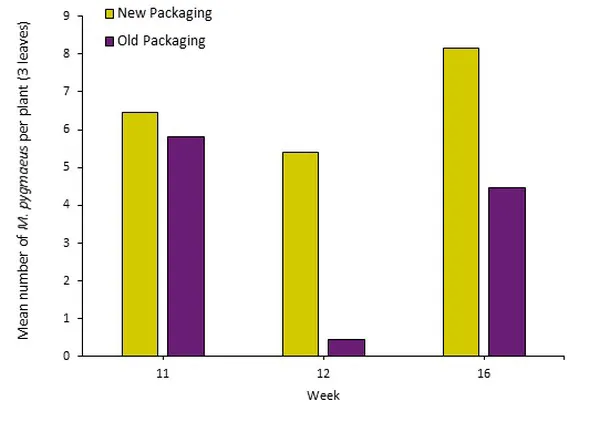Biobest has recently launched sustainable packaging for its Macrolophus-System. "Recent field trials carried out in commercial tomato crops in Belgium and the Netherlands have shown impressive improvements in the establishment of Macrolophus pygmaeus - due to benefits conferred by our new and improved 100% biodegradable packaging," the team stated. The original plastic bottle, containing vermiculite carrier, has been replaced with a 100% biodegradable cardboard carton with a removable lid.
The carton contains honeycomb paper - which helps protect the sensitive, delicate-winged mirid bug, which likes to hide - and a gel formulation providing water for the adult predators during transport.

In the Belgium trial, led by Rob Moerkens, Macrolophus was introduced, with 1.6 predators per m2. Predators supplied in the new packaging were released along full rows. Predators supplied in the old packaging format were distributed using cardboard Bio-Boxes. The trial was replicated, with four plots in total.
To aid predator establishment, the insects were given half a kilo of Artemac, a shrimp-based food source, per hectare. In the trial in the Netherlands, led by Gert-Jan de Vast, two separate introductions of Macrolophus were made in a commercial tomato crop with 1 predator/m2. Once again, Macrolophus was supplied either in the new sustainable packaging and released in full rows, or in the old packaging and released into Bio-Boxes.
For the next two weeks, the plant-based feed supplement Nutrimac was used, with 0.3kg being used per hectare. Over the subsequent six weeks, Artemac was distributed in full rows and three rows on either side at 0.5 kg/ha.

Macrolophus-System rates more than double
The results from both trials consistently showed the number of Macrolophus per plant where predators had been supplied in the ‘new packaging’ was significantly improved compared to the ‘old packaging’ and original release system: in the Belgium trial, the average Macrolophus numbers per plant for the new packaging and release system were more than double that of the old packaging and Bio-Boxes.

Figure 1: Mean number of M. pygmaeus per plant (3 leaves) in Belgian greenhouse. Macrolophus adults were introduced at a rate of 1.6/m2. The new packaging was released along full rows. The old packaging was distributed using the Bio-Boxes. Artemac was introduced on a weekly rate for 7 weeks, at a quantity of 0.5 kg/ha.
In the Netherlands trial, the improvements were even greater. Macrolophus establishment in the tomato crop was nearly three times greater where the predators had been supplied in the new packaging.

Figure 1: Mean number of M. pygmaeus per plant (3 leaves) in Dutch greenhouse. Macrolophus adults were introduced at a rate of 1/m2. The new packaging was released along full rows. The old packaging was distributed using the Bio-Boxes. Nutrimac was introduced for 2 weeks at a quantity of 0.3 kg/ha, followed by an introduction of Artemac at a quantity of 0.5 kg/ha for 6 weeks.
Adults arrive in optimal condition
"From these results, we conclude the adaptations we have made to our new sustainable packaging for Macrolophus-System are helping to ensure adults arrive in optimal condition, improving overall product quality, boosting establishment levels, and ultimately control," the Biobest team concluded.

